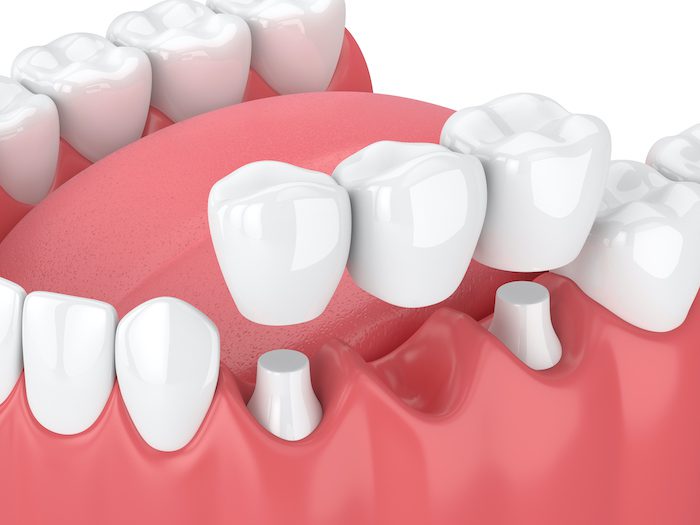Dental bridges are one of the primary restorations we use to replace missing teeth. They’re a comfortable replacement for missing teeth, replacing one missing tooth or multiple consecutive missing teeth. We offer dental bridges as a restorative dental service in our Denton, TX dentist office. We want to restore your smile, giving you back both function and aesthetics so you’re confident in your smile again.
Replace Missing Teeth with a Dental Bridge in Denton, TX
We offer both removable and fixed bridges. Both options are ideal for different reasons. We work with each patient to create a personalized treatment plan that’s perfect for their individual needs.

Traditional Fixed Bridge
A fixed dental bridge is a type of non-removable dental prosthesis that we use to replace missing teeth. This dental restoration will restore your ability to chew correctly and the aesthetics of your smile. Your dentist may choose this option when several teeth are missing and healthy teeth are available on both sides of the gap.
A fixed dental bridge typically consists of two main components: abutments and pontics. The abutments are the healthy teeth or implants that provide support at each end of the bridge, while the pontics are the artificial teeth that fill the gap.
To receive a dental bridge, you will need attend at least two dental appointments. At the first one, your dentist will remove some of the enamel from the abutment teeth creating room for the crowns. We will also take impressions that a detal lab will use to fabricate the bridge. To protect your teeth until your bridge is ready, we will secure a temporary bridge. Your dentist will fit, adjust, and cement the permanent bridge at the next dentist appointment.
A fixed dental bridge offers you many benefits. The top advantages include improved oral function, enhanced appearance,
and tooth shifting prevention. A fixed, traditional bridge is also very durable, lasting about 10 to 15 years. However, your new prosthesis will require proper care that includes good oral hygiene habits and regular dental visits. Caring for your bridge will help it last for many years, sometimes longer than the average lifespan of a bridge.
A traditional bridge also comes with a few risks. The main risks that should concern you include decay under the crowns and the need for replacement over time.
Cantilever Bridge
A cantilever dental bridge is a type of dental prosthesis we use to replace missing teeth when only one adjacent tooth is available. The single tooth will support the dental bridge. A traditional bridge requires a crown on each side of the gap while a cantilever bridge is anchored to abutment tooth. The design is useful if you have teeth missing on one side of the gap or only one healthy adjacent tooth.
The cantilever bridge has one or more pontics to replace the missing teeth. These pontics will get support from the crown your dentist places on the abutment tooth. The bridge restores your chewing function, speech, and smile’s aesthetics.
Your dentist will suggest a cantilever bridge in areas of your mouth where the biting force is low. We often use them for front teeth. A cantilever bridge is not the best choice for replacing molars. The molars ensure a lot of stress and pressure when chewing. We also consider cantilever dental bridges when there are aesthetic concerns about using visible teeth or when the adjacent tooth is already supporting another dental restoration.
However, a cantilever bridge requires less preparation and alteration of adjacent teeth than traditional bridges. They can restore oral function and appearance while preventing your remaining teeth from shifting. However, they come with a few limitations, such as increased stress on the single supporting tooth. This stress on one tooth leads to complications like tooth fractures or bridge loosening over time. Because of this stress load, a cantilever bridge can have a shorter lifespan that requires replacement. Proper oral hygiene and regular dental check-ups are vital to maintain cantilever bridge.
Maryland Bridge
A Maryland dental bridge is a type of dental prosthesis that we may use to replace one or more missing teeth. This type of bridge requires minimal alteration to the adjacent teeth compared to a traditional dental bridge. This bridge comprises a metal or porcelain framework with the pontic attached. The framework has wing-like extensions that your dentist will bond to the back of the adjacent teeth. This approach eliminates the need for a dental crown on these adjacent teeth.
The Maryland bridge will bridge the gap left by missing teeth. Its unique design allows us to preserve your natural tooth structure since we won’t have to reshape the adjacent teeth to create room for a crown. We use Maryland bridges for front teeth, where there is a great need for good aesthetics and the biting forces are lower.
The process of getting a Maryland bridge involves a thorough assessment to determine if your teeth are stable enough to support it. Your dentist will need to remove a small amount of enamel from the back of the adjacent teeth to prepare those teeth for cementation. We will also take impressions that a dental lab will use to create the custom bridge. Once it’s ready, your dentist will bond it to the back of adjacent teeth.
Maryland bridges offer several benefits, including the preservation of natural tooth structure, reduced risk of pulpal trauma, and quicker placement. This type of bridge is also cheaper and requires less time to fabricate. However, they have limitations, such as the potential for the metal framework to cause discoloration of the bonded teeth and a tendency to debond over time. We may suggest a Maryland dental bridge to replace one tooth in low-stress areas, primarily for anterior teeth.
Removable Dental Bridges
Removable dental bridges are worn throughout the day but typically are taken out at night. They’re also used as a temporary restoration if you have implants placed for a fixed bridge and are waiting for them to heal. Some of the biggest benefits of removable dental bridges are that they’re a cost-effective and quick restoration to get. They’re minimally invasive, and you don’t require surgery like you do with implant-supported bridges.
This type of dental bridge uses your natural teeth to support it. There’s one anchor tooth on each end of the bridge’s span. This puts a lot of stress and strain on the natural teeth. Anchor teeth are more likely to wear down faster and succumb to tooth decay and other oral health problems. We recommend fortifying the anchor teeth with dental crowns. Though we have to remove natural tooth structure to place the crowns, they take on the stress of supporting the restoration.
While removable dental bridges are cheaper in the long run, you must readjust or replace them in their lifespan. Your jawbone continues to deteriorate and changes the fit of the bridge. They also require removal at night, special cleaning, and maintenance to stay functional. You also have some food limitations and may be unable to break down certain foods.
Implant-Supported Bridges
Instead of using your natural teeth to support the bridge, dental implants anchor this bridge at either side of the span. With this type of bridge, you get benefits only dental implants can provide. For instance, they prevent further jawbone deterioration and promote bone regeneration for the implants to fuse with the jawbone. You regain almost 100% of your bite function and don’t have to eliminate foods or remove the restoration. It’s fixed, staying in your mouth at all times.
This option also eliminates harming your current natural tooth structure. Supporting a dental bridge means taking on a lot of stress and strain. Dental implants can handle it. They’re the most stable dental restoration.
Though they come with many benefits, the most common problem with dental implants is price. Because they require a surgical component, there are more costs involved. It also takes longer to get your final restoration. Dental implant posts need around 3-6 months to heal before you can get the final bridge.
Getting Your Dental Bridge
As with all restorations, we start with a consultation in our office. We’ll perform a thorough oral examination, utilizing diagnostic tools if needed. We’ll also discuss your cosmetic goals, medical history, and any current oral health problems. This helps us determine which bridge is the right fit for you.
We surgically place the dental implant posts in your jawbone for an implant-supported bridge. We’ll provide a temporary removable bridge while the implants heal and fuse with your jawbone. Pieces called abutments attach to the implant posts to connect the final restoration, which is custom-made by a dental lab. Then, we permanently fix the restoration to the implants.
We’ll prepare the teeth and take impressions for a removable bridge to custom-make the dental crowns. The dental bridge will also be custom-made to meet your specifications. We ensure that all restorations fit the size, shape, and shade of the rest of your smile.
Frequently Asked Questions
Can dental bridges be repaired if damaged?
Yes, we can often repair bridges if they are damaged. The possibility depends on the extent of the damage and the type of bridge. Sometimes, we can fix issues like chips or loose cement without replacing the entire bridge. However, significant damage may require a new bridge.
Will a dental bridge affect my speech or ability to eat?
At first, you may notice subtle changes in your speech or eating habits after getting a dental bridge. This is normal as your mouth adjusts to the bridge. Most people adapt quickly, and any difficulties usually disappear within a few days. Soon, you’ll likely find that speaking and eating feels natural again.
How long does it take to get used to a Maryland bridge?
Getting used to a Maryland bridge typically takes a few days to a couple of weeks. Since it’s bonded to the back of your adjacent teeth and less bulky, the adjustment period is often shorter. You’ll gradually become comfortable speaking and eating normally. Patience and practice help speed up the process.
Does insurance cover dental bridges?
Many dental insurance plans cover dental bridges, especially if they’re needed for medical reasons like tooth loss due to decay or injury. Coverage can vary depending on your specific policy and provider. It’s best to check with your insurance company to understand what’s included. Our office can also help you navigate your insurance benefits.
Are dental bridges removable for cleaning?
Traditional dental bridges are fixed and not removable for cleaning. They are cemented in place and function like natural teeth. You’ll need to clean under the bridge using special floss or interdental brushes to maintain good oral hygiene. However, there are removable options like partial dentures if removability is important to you.
How long after a tooth extraction can you get a bridge?
You can usually get a dental bridge once your gums and surrounding tissues have healed after an extraction. This healing period typically takes a few weeks to a few months, depending on the individual. Your dentist will assess when your mouth is ready for the bridge. Planning ahead can help minimize the time you spend without a tooth.
Schedule a Consultation
A dental bridge can be the right solution to replace your missing teeth. Call us or schedule a consultation online to learn more.
